Did you know U.S. golf courses use 1.5 billion gallons of water every day? That’s enough to fill 2,270 Olympic-sized swimming pools! This fact shows how golf courses and the environment are connected.
Golf courses cover over 2 million acres in the U.S. They have big effects on the environment, both good and bad. From water use to helping wildlife, their impact is wide and complex.
Golf courses need a lot of land and water, but they also offer green spaces in cities. Some even help wildlife and fix damaged lands. The debate over golf courses’ environmental impact is ongoing.
Key Takeaways
- U.S. golf courses use 1.5 billion gallons of water daily
- Golf courses occupy over 2 million acres in the United States
- They can have both positive and negative environmental impacts
- Some courses serve as wildlife habitats and sanctuaries
- Water usage and land clearing are major environmental concerns
- Golf course sustainability is an evolving field of study and practice
Table of Contents
- 1 The Environmental Impact of Golf Courses: An Overview
- 2 Negative Environmental Impacts of Golf Courses
- 3 Positive Environmental Contributions of Golf Courses
- 4 Wildlife Habitats on Golf Courses
- 5 Sustainable Practices in Modern Golf Course Management
- 6 Case Studies: Environmentally Friendly Golf Courses
- 7 The Role of Golf Organizations in Environmental Stewardship
- 8 Challenges in Balancing Golf and Environmental Conservation
- 9 The Future of Environmentally Sustainable Golf
- 10 Comparing Golf Courses to Other Land Uses
The Environmental Impact of Golf Courses: An Overview
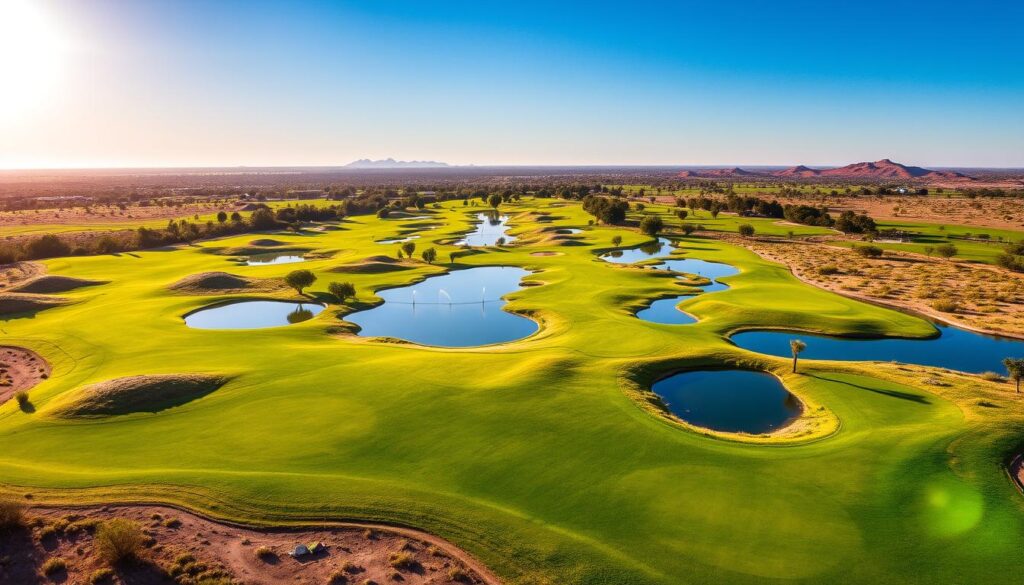
Golf courses have a big impact on our landscapes. With 16,000 courses covering about 2 million acres in the U.S., their environmental footprint is huge. This area is bigger than Delaware, showing how golf affects our ecosystems.
Land Use and Habitat Transformation
Creating golf courses often changes habitats. In California, 137,000 acres are used for golf. This could house millions, making us think about recreational needs versus environmental protection.
Water Consumption and Management
Golf courses use a lot of water. U.S. courses use 1.5 billion gallons every day. Each course uses 93,750 gallons daily. This high demand strains local water resources, especially in dry areas like California, where over 1,000 courses exist.
Chemical Usage
Pesticides and fertilizers keep greens looking good. But, they can pollute groundwater and harm local ecosystems. The golf industry is under pressure to use fewer chemicals and be more sustainable.
Energy Consumption and Carbon Footprint
Golf courses need a lot of energy for upkeep. This energy use adds to the sport’s carbon emissions. Yet, well-managed courses can also help by absorbing carbon through their grass and trees.
Despite challenges, golf is becoming more sustainable. The U.S. Golf Association will spend $30 million to cut water use over 14 years. Some courses are turning into natural parks, like Orchard Hills Park in Ohio, which restored 72 acres of land. These changes show golf can face environmental challenges while staying popular.
Negative Environmental Impacts of Golf Courses
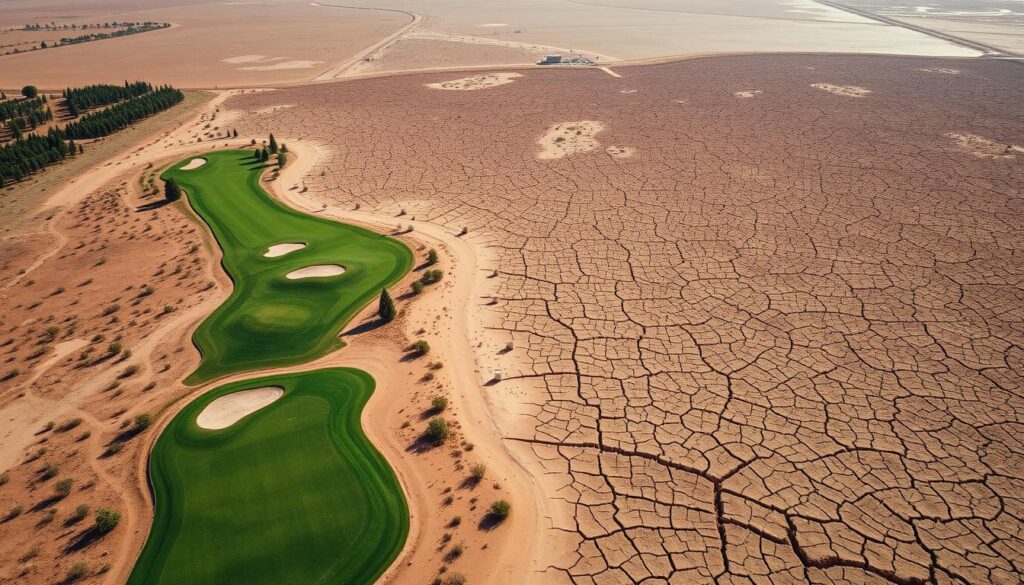
Golf courses can harm the environment a lot. With over 38,000 courses worldwide, their effects are huge. In the United States, 16,000 golf courses use 1.5 billion gallons of water every day.
Deforestation and Habitat Loss
Golf course development often causes deforestation and habitat loss. Native plants are replaced with turfgrass. This hurts wildlife that needs these areas to survive.
Water Scarcity
Water depletion is a big problem, especially in dry areas. Each U.S. golf course uses 93,750 gallons of water daily. In Utah, golf courses need about 9 million gallons a day, which is like 13 Olympic-sized pools.
Chemical Pollution
Golf courses use many pesticides and herbicides. These chemicals can harm wildlife if they get into soil and water. The golf industry uses around 50 pesticide active ingredients, some banned for home use because they’re harmful.
Soil Erosion and Degradation
Golf courses’ intensive land management can cause soil erosion and degradation. This makes nearby water sources less clean and hurts the ecosystem’s health.
Biodiversity Impact
Turning natural landscapes into golf courses hurts local biodiversity. It messes up ecosystems and food chains. This can lead to fewer native species.
| Environmental Issue | Impact |
|---|---|
| Water Usage | 1.5 billion gallons per day in the U.S. |
| Chemical Use | 50 pesticide active ingredients |
| Land Use | 16,000 golf courses in the U.S. |
Positive Environmental Contributions of Golf Courses

Golf courses have many unexpected benefits for the environment. They create green spaces in cities, support wildlife, and help combat climate change. We will now look at how golf courses positively impact our planet.
Green Spaces in Urban Areas
In cities, golf courses are vital green areas. They offer a place for people to enjoy nature and fresh air. These spaces also help cool down cities, making them more livable.
Wildlife Corridors and Sanctuaries
Golf courses can be sanctuaries for wildlife. They provide safe spaces for animals to live and move. Over 70% of golf course land is natural, giving animals plenty of room to thrive.
Carbon Sequestration
Golf courses help fight climate change by sequestering carbon. The grass and trees on courses absorb carbon dioxide. This reduces greenhouse gases in our atmosphere.
Wetland Preservation
Many golf courses have wetlands. These areas are critical for biodiversity and water quality. Golf course managers work to preserve or create new wetlands, protecting these vital ecosystems.
Repurposing Degraded Lands
Some golf courses transform old, damaged lands into green spaces. They turn former landfills or quarries into beautiful areas. This land repurposing cleans up and improves areas that were once environmental hazards.
While golf courses face various hazards, they also offer significant environmental benefits. From providing urban green spaces to supporting wildlife and fighting climate change, golf courses can be valuable assets to our environment when managed responsibly.
| Environmental Benefit | Impact |
|---|---|
| Urban Green Spaces | Cooling effect, improved air quality |
| Wildlife Sanctuaries | 70% of course area supports natural habitats |
| Carbon Sequestration | Grass and trees absorb CO2 |
| Wetland Preservation | Protects biodiversity and water quality |
| Land Repurposing | Transforms degraded areas into green spaces |
Wildlife Habitats on Golf Courses
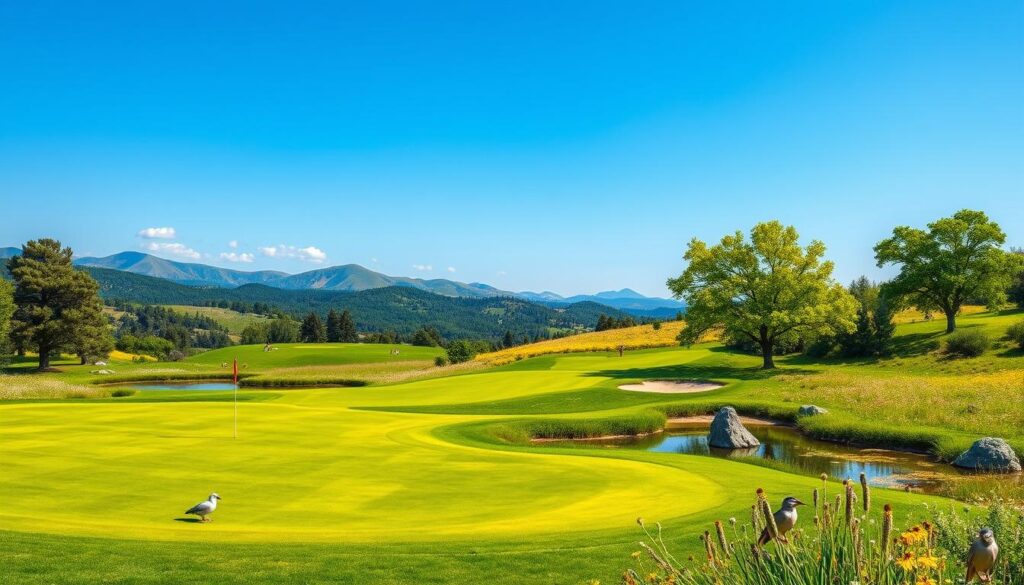
Golf courses are more than just places to play. They are important spots for biodiversity conservation. These large areas are perfect for habitat management and supporting native species. In England, over 100 golf courses are recognized as Sites of Special Scientific Interest, showing their ecological value.
Many golf clubs are taking on a new role. They’re working with local wildlife trusts to better manage their environments. For example, Northamptonshire County Golf Club improved its grass heath roughs. This created better homes for pollinators and reptiles.
Golf courses are becoming sanctuaries for wildlife. They offer homes for rare bats, beetles, and other creatures. Some clubs even have beehives to help pollinators. It’s surprising to see how golf courses can support diverse ecosystems while still being places for fun.
| Wildlife Type | Examples Found on Golf Courses |
|---|---|
| Birds | Hadeda Ibis, Bluebirds, Cedar Waxwings |
| Mammals | Deer, Foxes, Squirrels |
| Insects | Butterflies, Dragonflies, Beetles |
| Reptiles | Turtles, Various Lizard Species |
| Amphibians | Frogs, Toads |
Urban golf courses are vital green spaces in cities. They offer a safe place for wildlife like birds, deer, and coyotes. With the right care, these courses can be important parts of urban wildlife conservation. They show that golf and nature can live together peacefully.
Sustainable Practices in Modern Golf Course Management

Golf courses are now using eco-friendly methods to lessen their impact on the environment. They focus on saving natural resources and boosting biodiversity.
Water Conservation Techniques
Golf courses are using smart irrigation systems to cut down on water use. These systems check the weather and soil moisture to decide when to water. This has led to a 30% reduction in water use in some Utah courses.
Integrated Pest Management
IPM strategies are helping golf courses use fewer harmful chemicals. They now use natural controls and targeted treatments for pests. This has cut pesticide use by 50% on many courses.
Native Landscaping and Habitat Restoration
Golf courses are adding native plants to their landscapes. This supports local ecosystems and needs less upkeep. In New Mexico, courses like Marty Sanchez Links de Santa Fe have restored natural habitats.
Energy-Efficient Equipment and Facilities
Modern golf courses are investing in energy-saving equipment and buildings. Solar panels, LED lights, and electric golf carts are becoming more common. These upgrades can cut energy use by up to 40%.
Organic Maintenance Practices
Some courses are switching to organic maintenance. This involves using natural fertilizers and pest control. While it’s a challenge, organic maintenance can greatly reduce environmental harm.
| Sustainable Practice | Environmental Benefit | Cost Savings |
|---|---|---|
| Water Conservation | 30% reduction in water use | $20,000 annually |
| Integrated Pest Management | 50% reduction in pesticide use | $15,000 annually |
| Native Landscaping | Increased biodiversity | $10,000 in maintenance costs |
| Energy-Efficient Equipment | 40% reduction in energy use | $25,000 annually |
| Organic Maintenance | Improved soil health | $5,000 in chemical costs |
Case Studies: Environmentally Friendly Golf Courses

Golf courses are now using eco-friendly practices to reduce their environmental impact. NOw we will look at some examples of sustainable golf in action.
Heron Glen and Quail Brook Golf Courses
These New Jersey courses have earned River-Friendly certification. They save water and use natural pest control to protect local waterways.
Vineyard Golf Club
On Martha’s Vineyard, this course leads in organic golf. It avoids synthetic pesticides and fertilizers, showing that natural methods can keep greens lush.
Chambers Bay
Built on reclaimed land in Washington state, Chambers Bay shows golf’s power to beautify neglected areas. It uses native plants and saves water.
The Old Collier Golf Club
This Florida course is an Audubon Signature Sanctuary. It safeguards local wildlife and uses advanced irrigation systems to save water.
| Golf Course | Greens Fees (Weekday) | Greens Fees (Weekend) | Tee Times |
|---|---|---|---|
| Heron Glen | $49 | $69 | 6:00 AM – 6:00 PM |
| Quail Brook | $45 | $65 | 6:30 AM – 5:30 PM |
| Vineyard Golf Club | $200 (Members only) | $200 (Members only) | 7:00 AM – 5:00 PM |
| Chambers Bay | $175 | $275 | 6:00 AM – 7:00 PM |
| The Old Collier Golf Club | $195 (Members only) | $195 (Members only) | 7:30 AM – 6:00 PM |
These courses show that golf and nature can go hand in hand. They set high standards for sustainable golf. They prove that eco-friendly courses can offer great playing experiences while protecting the environment.
The Role of Golf Organizations in Environmental Stewardship

Golf organizations are vital in protecting our planet. They aim to keep the game alive while caring for the environment. We will now look at some important programs making a big impact.
USGA’s Environmental Research and Initiatives
The United States Golf Association (USGA) is at the forefront of environmental research. They focus on using less water and chemicals in golf course care. They’re investing $30 million over 14 years to make this happen. This shows their serious commitment to protecting our planet.
Golf Environment Organization (GEO) Certified® Program
The GEO Certification program promotes green practices worldwide. It helps golf courses improve their environmental standing. Courses that meet strict standards in water and habitat protection get this top honor.
Audubon Cooperative Sanctuary Program for Golf
The Audubon program honors courses that protect the environment. It focuses on wildlife care, reducing chemicals, and saving water. This program has turned many courses into safe havens for wildlife.
| Organization | Focus Areas | Impact |
|---|---|---|
| USGA | Water and chemical reduction | $30 million investment |
| GEO | Global sustainability | International certification |
| Audubon | Wildlife and resource management | Widespread habitat improvement |
These groups are changing golf’s view of nature. Their work shows that building golf courses can be eco-friendly. By following their advice, golf courses can lead in environmental protection.
Challenges in Balancing Golf and Environmental Conservation
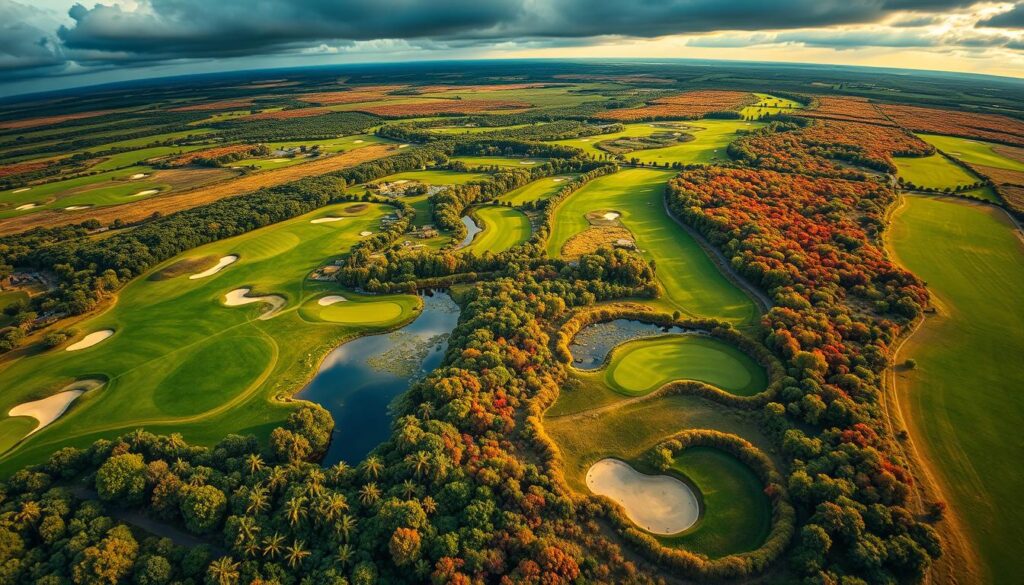
Golf courses have a tough job balancing money and protecting the environment. They need to stay profitable while also being green.
Economic Pressures vs. Environmental Investments
Golf course managers face a big challenge. They have to choose between spending on the environment and keeping costs low. Upgrades like water-saving tech or organic fertilizers can be expensive, especially for smaller courses.
Player Expectations and Course Conditions
Golfers want perfect greens and fairways. But, going green can make the course look different. This might upset players and hurt the course’s income.
Climate Change Impacts on Golf Course Management
Climate change makes things harder for golf courses. Weather extremes, changing seasons, and less water mean managers have to spend a lot to keep the course in shape.
Regulatory Compliance and Environmental Standards
Rules to protect the environment add to the problem. Courses must follow many laws, which means big investments in new systems and practices.
| Challenge | Impact | Potential Solution |
|---|---|---|
| Water Conservation | High costs, resource depletion | Smart irrigation systems |
| Chemical Reduction | Ecosystem health concerns | Integrated pest management |
| Energy Efficiency | Carbon footprint | Solar panels, efficient machinery |
| Waste Management | Environmental pollution | Recycling, composting programs |
Despite the challenges, many courses are finding new ways to please players and protect the environment. They’re teaching golfers about sustainability and making small changes. The goal is to create courses that are good for the planet and fun for everyone.
The Future of Environmentally Sustainable Golf
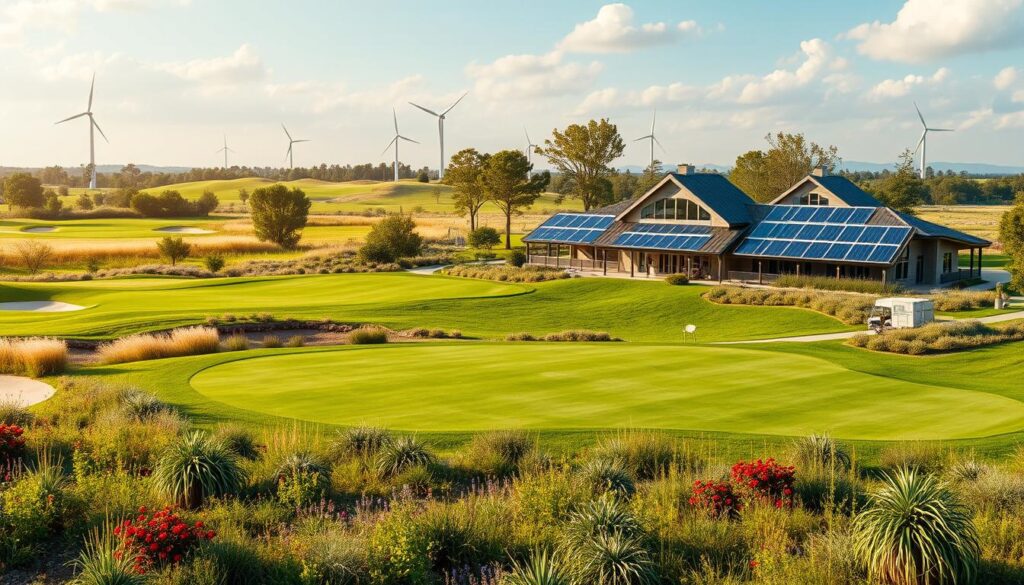
Golf is changing to face environmental challenges. New technologies and eco-friendly designs are transforming the sport. You’ll see new ways in course management, design, and education.
Emerging Technologies in Course Management
Smart irrigation and eco-friendly turf management are changing the game. They use less water and reduce chemical use. For instance, electric mowers are replacing diesel ones, cutting fuel use.
Trends in Eco-friendly Course Design
Golf architects are now designing courses inspired by nature. They use native plants and natural habitats. This design needs less water and maintenance, creating beautiful and challenging courses.
Education and Awareness Programs
Teaching about the environment is critical for golf’s future. There are online programs that can educate golfers and managers on sustainability. You’ll learn about water saving, wildlife protection, and eco-friendly practices.
Golf Courses as Research Sites
Golf courses are great for research. Scientists study ecosystems, water management, and climate change. This research improves course sustainability and helps the environment.
| Sustainability Measure | Impact |
|---|---|
| Smart Irrigation | Up to 30% water savings |
| Native Landscaping | 50% reduction in maintenance costs |
| Electric Equipment | 80% decrease in CO2 emissions |
| Environmental Education | 25% increase in sustainable practices adoption |
The future of golf is green. With these advancements, courses will be both challenging and eco-friendly. Golf is becoming a leader in sustainable recreation.
Comparing Golf Courses to Other Land Uses
Golf courses have their own set of benefits and challenges. They are often better than urban areas in preserving green space. With nearly 17,000 courses in the US, they offer a lot of space for wildlife and plants.
Golf Courses vs. Urban Development
Golf courses have more green space than cities. A study in Minnesota found that golf courses cool the air more than other land uses. This cooling effect helps fight urban heat islands, a big problem in cities.
Golf Courses vs. Agriculture
Golf courses use a lot of water, sometimes hundreds of thousands of gallons a day. They use more water and chemicals than farms. But, they can act as a buffer between homes and nature. The use of 50 pesticide active ingredients by the golf industry is a concern.
Golf Courses vs. Other Recreational Facilities
Golf courses need more land and resources than other sports areas. They create thousands of jobs and add billions to local economies. Scientists in Australia found that golf courses in Melbourne support more biodiversity than other green spaces. This shows the ecological value of well-managed golf courses in cities.

